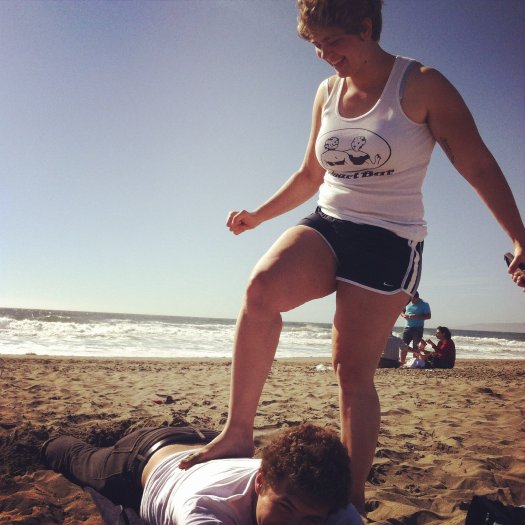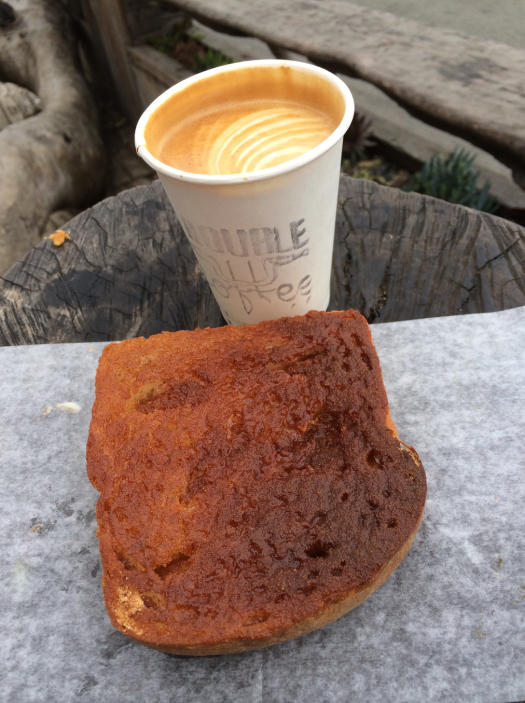
I work in downtown Chicago, and many of my clients are busy professionals who frequently travel for work. One of the most common requests I get from these clients is to help them come up with effective workouts to complete on the road.
I have previously written about staying healthy while traveling. This post provides more specific detail on how to get in a good workout on the road regardless of whether or not you have access to a gym.
Invest in some equipment
If you travel frequently, I recommend investing a few small pieces of equipment to improve the quality of your workouts.
The first is a band or set of bands. Bands help you train muscles which are hard to target without weights, such as your back. They also allow you to add extra resistance to bodyweight exercises. Bands travel well because they are lightweight and take up very little room in a suitcase.
You can buy a set of bands with different levels of resistance; adding a door anchor increases the number of possible exercises even more. I recommend this set to my online clients who train at home. You can also buy single bands or packs of bands here, here, and here. Check out this video from ResistanceBandTraning.com for plenty of inspiration on band training:
Like bands, sliders help you target hard-to-train areas and make traditional bodyweight exercises like pushups and lunges more challenging. You can buy a fancy pair of fitness sliders here, but I’ve found regular furniture sliders from the hardware store work just as well on most floors. These usually cost $15 or less. Check out this video from low-tech training wiz Ross Enamit for some ideas on how to use sliders in your workouts:
Finally, get a jump rope. Jumping rope is a great way to get your heart rate up and work on your coordination. You can jump rope just about anywhere, making it the ideal training tool for the road warrior.
If your hotel has a gym with weights…
Some of you are lucky enough to stay at hotels with gyms. Nice hotel gyms sometimes have a set of dumbbells up to 50lbs, which means you can create a workout that resembles your gym workouts back home. However, for some people the dumbbells at the hotel gym won’t be heavy enough to provide a real challenge. The good news is there are ways to modify exercises to make lighter weights feel more demanding:
- Slow down the eccentric portion of the lift. For example, if you are doing a goblet squat, sit down as slowly as you can. If you are doing a dumbbell row, lower the weight as slowly as you can.
- Add in isometric pauses. Hold the flexed position of the exercise for 1-5 seconds. Try to squeeze working muscles as hard as you can and maintain tension throughout your body during the pause. For a squat, pause in the bottom. For a row, pause at the top. You can also add a pause in the stretched position of exercises such as curls, flyes, and rows.
- Increase the volume. Lighter weights feel much more challenging when you perform more reps. If you’ve never tried performing sets of 20 rep squats, you are in for a real treat.
- Group exercises together. This works especially well if you group exercises for the same body part. For example, you could perform a set of dumbbell flyes before your set of dumbbell bench press or a set of goblet squats before some walking lunges. These groupings will make each exercise feel more challenging so you won’t need to use as much weight to get a good training effect.
Read more: How to Train Hard at a Bare Bones Commercial Gym
Another way to make your workout more challenging is to add in some higher intensity cardio. Most hotel gyms have at least one piece of cardio equipment such as an elliptical, treadmill, or stationary bike. You can add cardio intervals to increase the conditioning demands of any workout. Hop on the equipment for 30-90 seconds at an all-out pace in between sets of strength exercises or at the end of a larger strength circuit. (Note – Please do not attempt treadmill sprints unless you are an experienced runner.)
Read more: Improve Your Conditioning with Finishers
If you don’t have access to a gym…
You can have a great workout in your hotel room without a single piece of equipment. Choose a handful of exercises from the following list:
- Squats
- Glute bridges and single-leg glute bridges
- Jumps including squat jumps and jumping jacks
- Single-leg exercises including lunges, split squats, and single-leg deadlifts
- Pushups and advanced pushup variations including alligator pushups, dive bomber pushups, and clapping pushups
- Core exercises including planks, side planks, other plank variations, mountain climbers, dead bugs, leg lowers, and russian twists
- Crawling (if you have space)
Always consider your injury history and skill level when choosing exercises. For example, jump squats would be a poor choice for someone with knee pain but a good choice for a stronger trainee for whom bodyweight squats are fairly easy. In general, adding an explosive or jumping component to an exercise will make it more challenging. Jump squats, jumping lunges, and clapping pushups are good examples.
If you have purchased any of the equipment mentioned above, you can greatly expand your repertoire of hotel room exercises. Bands allow you train your back and arms. Sliders allow you to train your hamstrings using leg curls. Both pieces of equipment allow you to progress other exercises by adding some external resistance.
Putting it all together
Below are a few of my favorite travel workout templates. These example workouts can all be performed with minimal equipment in your hotel room, although you could easily modify them to include weights if you have access to a gym.
When creating your own workouts, try to be as balanced as possible. Each workout will ideally contain one exercise from each of the major movement patterns (squat, hinge, push, pull, 1-leg, core). Add in some conditioning using a jump rope or cardio equipment to make the workout more challenging.
Many of these examples were inspired by or taken from Jen Sinkler’s fantastic Lift Weights Faster product, which is a great resource for people who want to train with minimal equipment.
Circuit: Complete a set number of rounds (usually 3-5) as quickly as possible
Example: complete 3-5 rounds of the following:
- 50 jump rope or jumping jacks
- 20 mountain climbers each leg
- 30 squats
- 20 dead bugs (10 each side)
- 10 push-ups
Density: Set a timer and complete as many rounds as possible before time runs out
Example: Complete as many rounds of the follow as possible in 20 minutes:
- 10 reverse or jumping lunges each side
- 15 band pull aparts
- 20 glute bridges or 1-leg glute bridges
- 15 push-ups
- 10 dead bugs each side
Ladder: Complete an ascending or descending number of reps of each exercise.
Example: Complete the following ladder:
- 10 squats or squat jumps
- 10 superman
- 10 reverse lunges each side
- 10 pushups
- 10 side lunges each side
Next round 9 reps, then 8 reps, etc. Or if you have less time you could do next round 8 reps, then 6 reps, etc.
Make the best of your situation
You don’t need a lot of equipment or time to have an effective workout on the road. Invest in a few small pieces of equipment or choose from a list of bodyweight exercises you enjoy. Use intervals, training tempo, increased volume, and exercise groups to increase the challenge of a workout. Set aside time each day to exercise while on the road and reap the benefits of more consistent training without constant disruption.
If you’re serious about getting in shape, you have to find time to work out. However, despite the best intentions, it’s difficult to train when you’re busy, stressed, or on the road. I created my 4C System course to help busy professionals overcome these obstacles and become more consistent with training. This totally free five-day email course takes you through the exact steps I use with my clients. Sign up below and you’ll get the first lesson right away.



















